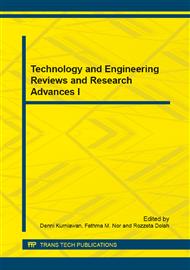[1]
C. Rafols, D. Barcelo, Determination on mono- and disulphonated azo dyes by liquid chromatograpgy-atmospheric pressure ionization mass spectrometry, Journal of Chromatography A. 777 (1997) 177-192.
DOI: 10.1016/s0021-9673(97)00429-9
Google Scholar
[2]
I.S. Thakur, Xenobiotics: pollutants and their degradation-mathane, benzene, pesticides, bioabsorption of metals, Environmental Microbiology.
Google Scholar
[3]
A.A. Pandey, P. Singh, L. Iyengar, Bacterial decolorization and degradation of azo dyes, Journal of Biodeterioration and Biodegradation. 59 (2007) 73–84.
DOI: 10.1016/j.ibiod.2006.08.006
Google Scholar
[4]
C.I. Pearce, J.R. Lloyd, J.T. Guthrie, The removal of color from textile waste water using whole bacterial cells: review, Dyes and Pigments. 58 (2003) 179-196.
DOI: 10.1016/s0143-7208(03)00064-0
Google Scholar
[5]
G.F. Chan, N.A.A. Rashid, L.L. Koay, S.Y. Chang, W.L. Tan, Identification and optimization of novel NAR-1 bacterial consortium for the biodegradation of Orange II, Insight Biotechnol. 1 (2011) 7–16.
DOI: 10.5567/ibiot-ik.2011.7.16
Google Scholar
[6]
M. Quadroni, P. James, P. Dainese-Hatt, M.A. Kertesz, Proteome mapping, mass spectrometric sequencing and reverse transcription-PCR for characterization of the sulfate starvation-induced response in Psedomonas cepacia aeruginosa PAO1, European Journal of Biochemistry. 266(3) (2003).
DOI: 10.1046/j.1432-1327.1999.00941.x
Google Scholar
[7]
A. Kahnert, M.A. Kertesz, Characterization of a Sulfur-regulated Oxygenative Alkylsulfatase from Pseudomonas putida S-313, Journal of Biological Chemistry. 275(41) (2000) 31661-31667.
DOI: 10.1074/jbc.m005820200
Google Scholar
[8]
E. Eichhorn, J.R. van der Ploeg, T. Leisinger, Deletion Analysis of the Escherichia coli Taurine and Alkanesulfonate Transport Systems, J. Bacteriol. 182(10) (2000) 2687-2695.
DOI: 10.1128/jb.182.10.2687-2695.2000
Google Scholar
[9]
Tsang, S.H. Jimmy, P.J. Sallis, A.T. Bull, D.J. Hardman, A monobromoacetate dehalogenase from psedumonas cepacia MBA4, Archives of microbiology. 150 (1988) 441-446.
DOI: 10.1007/bf00422284
Google Scholar
[10]
M. E. Clark, Q. He, Z. He, K.H. Huang, E.J. Alm, X. Wan, T.C. Hazen, A.P. Arkin, J.D. Wall, J. Zhou, M. W Fields, Temporal transcriptomic analysis as desulfovibrio vulgaris hildenborough transitions into stationary phase during electron donor depletion, Applied and Environmental Biotechnology. 72 ( 2006) 5578–5588.
DOI: 10.1128/aem.00284-06
Google Scholar
[11]
H.L. Jensen, Decomposition of chloro-substituted aliphatic acids by soil bacteria, Canadian Journal of Microbiology. 3 (1957) 151–164.
DOI: 10.1139/m57-019
Google Scholar
[12]
Pandey, Gunjan, R.K. Jain, Bacterial Chemotaxis towards Environmental Pollutants : Role in Bioremediation, Applied and Environmental Microbiology. 68 (2002) 5789-5795.
DOI: 10.1128/aem.68.12.5789-5795.2002
Google Scholar
[13]
Babbitt, C. Patricia, G.L. Kenyon, B.M. Martin, H. Charest, M. Slyvestre, J.D. Scholten, K.H. Chang, P.H. Liang, D. Dunaway-Mariano, Ancestry of the 4-chlorobenzoate dehalogenase: analysis of amino acid sequence identities among families of acyl: adenyl ligases, enoyl-CoA hydratases/isomerases, and acyl-CoA thioesterases, Biochemistry. 31 (1992).
DOI: 10.1021/bi00139a024
Google Scholar
[14]
Mayer, Jutta, A.M. Cook, Homotaurine metabolized to 3-sulfopropanoate in Cupriavidus necator H16: enzymes and genes in a patchwork pathway, Journal of bacteriology. 191 (2009) 6052–6058.
DOI: 10.1128/jb.00678-09
Google Scholar
[15]
Egland, G. Paul , J. Gibson, C.S. Harwood, Benzoate-coenzyme A ligase, encoded by badA, is one of three ligases able to catalyze benzoyl-coenzyme A formation during anaerobic growth of Rhodopseudomonas palustris on benzoate, Journal of bacteriology. 177 (1995).
DOI: 10.1128/jb.177.22.6545-6551.1995
Google Scholar
[16]
K. Perei, G. Rákhely, I. Kiss, B. Polyák, K.L. Kovács, Biodegradation of sulfanilic acid by Pseudomonas paucimobilis, Applied microbiology and biotechnology. 55 (2001) 101–107.
DOI: 10.1007/s002530000474
Google Scholar


